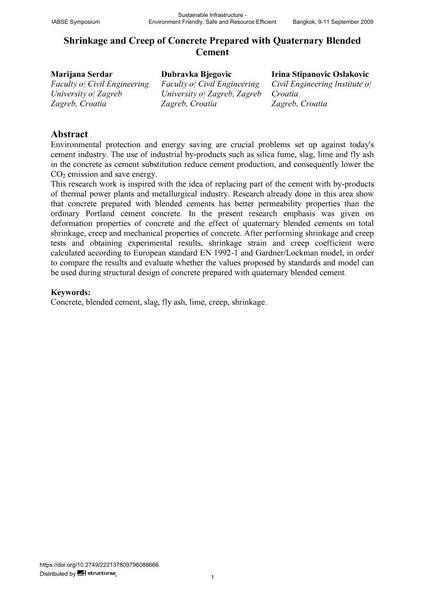Shrinkage and Creep of Concrete Prepared with Quaternary Blended Cement

|
|
|||||||||||
Bibliografische Angaben
| Autor(en): |
Marijana Serdar
Dubravka Bjegovic Irina Stipanovic Oslakovic |
||||
|---|---|---|---|---|---|
| Medium: | Tagungsbeitrag | ||||
| Sprache(n): | Englisch | ||||
| Tagung: | IABSE Symposium: Sustainable Infrastructure - Environment Friendly, Safe and Resource Efficient, Bangkok, Thailand, 9-11 September 2009 | ||||
| Veröffentlicht in: | IABSE Symposium Bangkok 2009 | ||||
|
|||||
| Seite(n): | 123-131 | ||||
| Anzahl der Seiten (im PDF): | 9 | ||||
| Jahr: | 2009 | ||||
| DOI: | 10.2749/222137809796088666 | ||||
| Abstrakt: |
Environmental protection and energy saving are crucial problems set up against today's cement industry. The use of industrial by-products such as silica fume, slag, lime and fly ash in the concrete as cement substitution reduce cement production, and consequently lower the CO₂ emission and save energy. This research work is inspired with the idea of replacing part of the cement with by-products of thermal power plants and metallurgical industry. Research already done in this area show that concrete prepared with blended cements has better permeability properties than the ordinary Portland cement concrete. In the present research emphasis was given on deformation properties of concrete and the effect of quaternary blended cements on total shrinkage, creep and mechanical properties of concrete. After performing shrinkage and creep tests and obtaining experimental results, shrinkage strain and creep coefficient were calculated according to European standard EN 1992-1 and Gardner/Lockman model, in order to compare the results and evaluate whether the values proposed by standards and model can be used during structural design of concrete prepared with quaternary blended cement. |
||||
| Stichwörter: |
Beton Schwinden
|
||||
